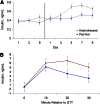Nutritional interventions to alleviate the negative consequences of heat stress
- PMID: 23674792
- PMCID: PMC3650495
- DOI: 10.3945/an.112.003376
Nutritional interventions to alleviate the negative consequences of heat stress
Abstract
Energy metabolism is a highly coordinated process, and preferred fuel(s) differ among tissues. The hierarchy of substrate use can be affected by physiological status and environmental factors including high ambient temperature. Unabated heat eventually overwhelms homeothermic mechanisms resulting in heat stress, which compromises animal health, farm animal production, and human performance. Various aspects of heat stress physiology have been extensively studied, yet a clear understanding of the metabolic changes occurring at the cellular, tissue, and whole-body levels in response to an environmental heat load remains ill-defined. For reasons not yet clarified, circulating nonesterified fatty acid levels are reduced during heat stress, even in the presence of elevated stress hormones (epinephrine, glucagon, and cortisol), and heat-stressed animals often have a blunted lipolytic response to catabolic signals. Either directly because of or in coordination with this, animals experiencing environmental hyperthermia exhibit a shift toward carbohydrate use. These metabolic alterations occur coincident with increased circulating basal and stimulated plasma insulin concentrations. Limited data indicate that proper insulin action is necessary to effectively mount a response to heat stress and minimize heat-induced damage. Consistent with this idea, nutritional interventions targeting increased insulin action may improve tolerance and productivity during heat stress. Further research is warranted to uncover the effects of heat on parameters associated with energy metabolism so that more appropriate and effective treatment methodologies can be designed.
Conflict of interest statement
Author disclosures: R. P. Rhoads, L. H. Baumgard, J. K. Suagee, and S. R. Sanders: no conflicts of interest.
Figures

Similar articles
-
2011 and 2012 Early Careers Achievement Awards: metabolic priorities during heat stress with an emphasis on skeletal muscle.J Anim Sci. 2013 Jun;91(6):2492-503. doi: 10.2527/jas.2012-6120. Epub 2013 Feb 13. J Anim Sci. 2013. PMID: 23408824
-
Effects of heat stress on postabsorptive metabolism and energetics.Annu Rev Anim Biosci. 2013 Jan;1:311-37. doi: 10.1146/annurev-animal-031412-103644. Epub 2012 Dec 13. Annu Rev Anim Biosci. 2013. PMID: 25387022 Review.
-
Ruminant Nutrition Symposium: ruminant production and metabolic responses to heat stress.J Anim Sci. 2012 Jun;90(6):1855-65. doi: 10.2527/jas.2011-4675. Epub 2011 Dec 28. J Anim Sci. 2012. PMID: 22205665
-
Alterations in energy metabolism during exercise and heat stress.Sports Med. 2001;31(1):47-59. doi: 10.2165/00007256-200131010-00004. Sports Med. 2001. PMID: 11219501 Review.
-
Impacts of heat stress on immune responses and oxidative stress in farm animals and nutritional strategies for amelioration.Int J Biometeorol. 2021 Jul;65(7):1231-1244. doi: 10.1007/s00484-021-02083-3. Epub 2021 Jan 26. Int J Biometeorol. 2021. PMID: 33496873 Review.
Cited by
-
Short-term heat stress alters redox balance in porcine skeletal muscle.Physiol Rep. 2017 Apr;5(8):e13267. doi: 10.14814/phy2.13267. Epub 2017 Apr 28. Physiol Rep. 2017. PMID: 28455453 Free PMC article.
-
Effects of chitosan oligosaccharides on intestinal oxidative stress and inflammation response in heat stressed rats.Exp Anim. 2021 Feb 6;70(1):45-53. doi: 10.1538/expanim.20-0085. Epub 2020 Sep 11. Exp Anim. 2021. PMID: 32921697 Free PMC article.
-
Chitosan Oligosaccharides Protect Sprague Dawley Rats from Cyclic Heat Stress by Attenuation of Oxidative and Inflammation Stress.Animals (Basel). 2019 Dec 3;9(12):1074. doi: 10.3390/ani9121074. Animals (Basel). 2019. PMID: 31816916 Free PMC article.
-
Alpha lipoic acid supplementation ameliorates the wrath of simulated tropical heat and humidity stress in male Murrah buffaloes.Int J Biometeorol. 2019 Oct;63(10):1331-1346. doi: 10.1007/s00484-019-01750-w. Epub 2019 Jul 6. Int J Biometeorol. 2019. PMID: 31280374
-
Circular RNAs in the Regulation of Oxidative Stress.Front Pharmacol. 2021 Jul 27;12:697903. doi: 10.3389/fphar.2021.697903. eCollection 2021. Front Pharmacol. 2021. PMID: 34385919 Free PMC article. Review.
References
-
- IPCC. The intergovernmental panel on climate change 4th assessment report. Available from: http://www.ipcc.ch/. Accessed May 12, 2011. 2007.
-
- Luber G, McGeehin M. Climate change and extreme heat events. Am J Prev Med. 2008;35:429–35 - PubMed
-
- Meehl GA, Tebaldi C. More intense, more frequent, and longer lasting heat waves in the 21st century. Science. 2004;305:994–7 - PubMed
-
- Tan J, Zheng Y, Song G, Kalkstein LS, Kalkstein AJ, Tang X. Heat wave impacts on mortality in Shanghai, 1998 and 2003. Int J Biometeorol. 2007;51:193–200 - PubMed
Publication types
MeSH terms
Substances
LinkOut - more resources
Full Text Sources
Other Literature Sources
Medical

